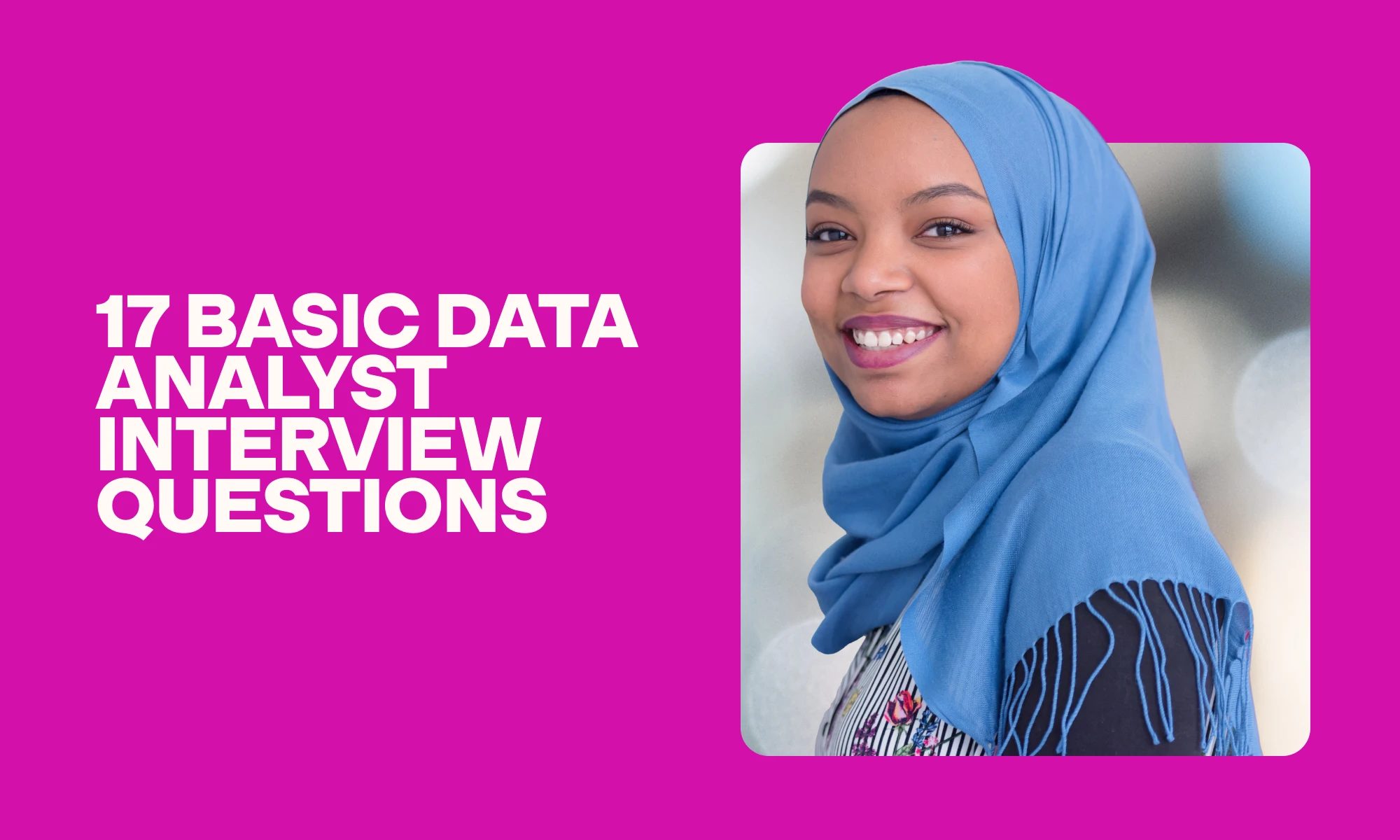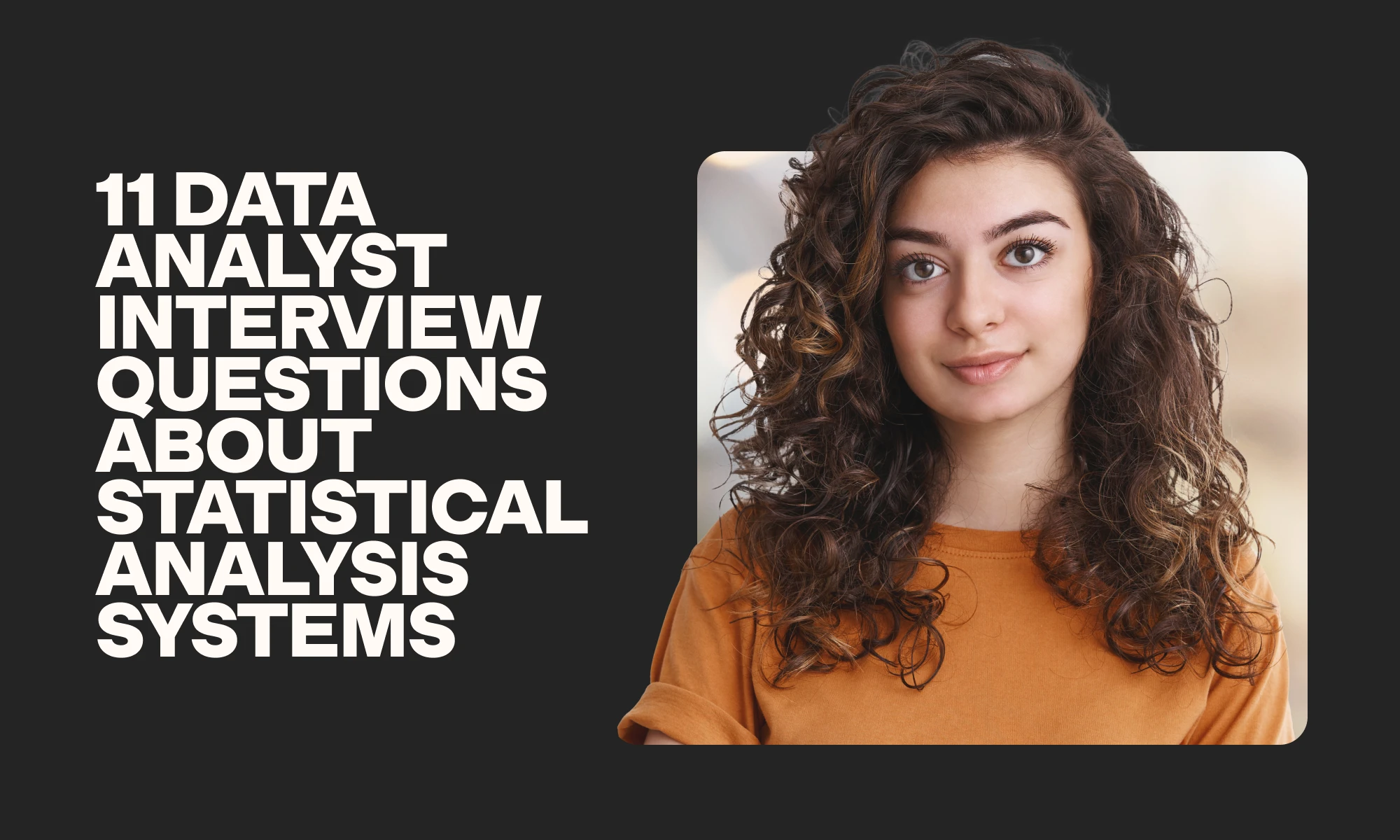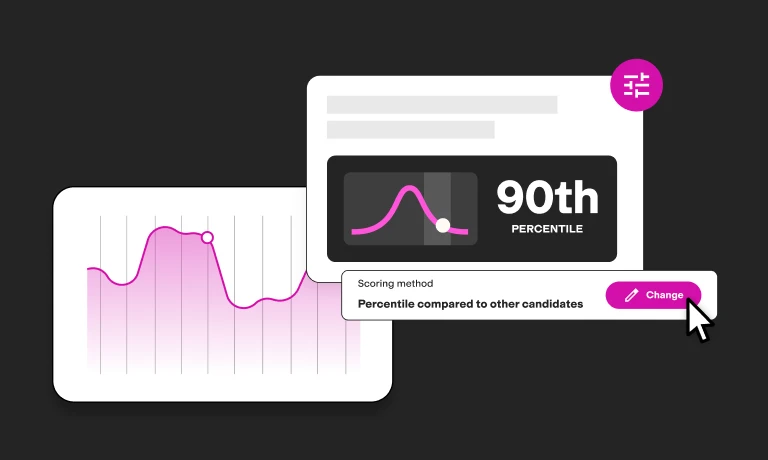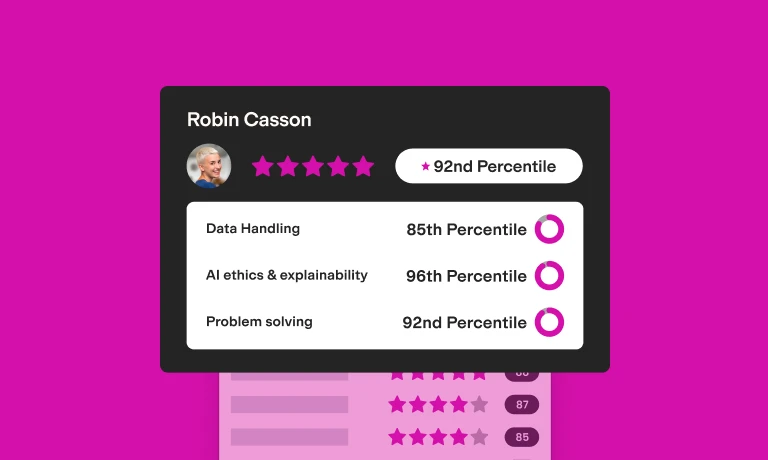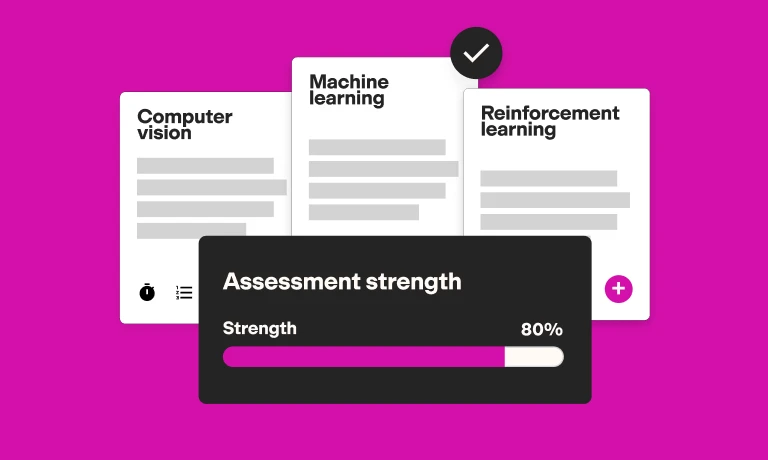Data handling and analysis are critical skills for enterprises making important daily decisions.
But how can businesses handle data so efficiently, and how do they use it for decision-making and operations?
A skilled data analyst or quantitative analyst play a significant part in data handling. If you don’t have one on your team, your decision-making process can suffer.
You need to take two steps when hiring a professional data analyst: Skills testing is essential for keeping time-to-hire to a minimum, while the interview stage ensures that you understand your candidates’ data analyst skills in more detail.
This article’s selection of data analyst interview questions will give you some ideas for the interview stage.
Check out the questions below to hire a professional data analyst.
Table of contents
- 17 basic data analyst interview questions
- 5 basic data analyst interview questions and answers
- 25 data analyst interview questions related to statistics
- 5 data analyst interview questions related to statistics and answers
- 11 data analyst interview questions about statistical analysis systems
- 5 data analyst interview questions related to SAS and answers
- 12 data analyst interview questions related to Tableau
- 5 data analyst interview questions and answers related to Tableau
- During which stage of the hiring process should you use data analyst interview questions?
- 5 tips to help you use data analyst interview questions when hiring
- Ask the right data analyst interview questions to hire the most suitable data analyst for your organization
17 basic data analyst interview questions
This section features 19 basic data analyst interview questions that you can ask your applicants to learn about their general data analyst skills.
What are the main differences between data mining and data analysis?
How is data mining different from data profiling?
Describe three indicators that suggest a data model is good.
Which soft skills are needed to be a good data analyst?
Which problems might a data analyst encounter when running an analysis?
Explain what the KNN imputation method is.
Which technical tools have you used for data analysis?
Name four best practices for data cleaning.
Explain what EDA is.
Explain why EDA skills are important in data analysis?
What is descriptive analytics?
What is predictive analytics?
What is prescriptive analytics?
Describe five sampling techniques that data analysts use.
Explain the main steps involved in data analysis.
What is data validation?
Explain the main steps involved in data validation.
5 basic data analyst interview questions and answers
Here, we have picked out five of the basic analyst interview questions above and included the answers you should look out for from your candidates.
1. Explain the main steps involved in data analysis.
The main steps involved in data analysis include:
Collecting and cleansing data: Data analysts gather the data from different sources.
Interpreting and transforming data: Analysts run models to analyze the data.
Modeling and generating reports on data: Data analysts implement the model and create documented reports for stakeholders.
2. What is data validation?
Data validation involves ensuring the data is accurate and of high quality. This is achieved by implementing checks in a report to guarantee the statistics’ consistency when stored.
3. Explain the main steps involved in data validation.
There are two main steps that data analysts follow when validating data:
Screening the data using different algorithms and checking for inaccurate values
Verifying the data by evaluating it and deciding whether the values must be used in the data
4. Explain what data cleansing is.
Data cleansing is also named data wrangling or, more simply, data cleaning. The process includes spotting and removing errors to increase the data’s quality.
5. Which skills are required to be a good data analyst?
Technical skills such as data cleaning, machine learning, data visualization, Python, SQL, NoSQL, and calculus are required to be a good data analyst.
It’s also important to know how to use Microsoft Excel and VBA to make it easier for data analysts to do their job.
The best insights on HR and recruitment, delivered to your inbox.
Biweekly updates. No spam. Unsubscribe any time.
25 data analyst interview questions related to statistics
The following 25 data analyst interview questions will help you learn more about your candidates’ knowledge of statistics.
Explain what average imputation is.
Explain what listwise deletion is.
Explain what regression substitution is.
Explain what multiple imputations does.
Explain what nominal distribution means.
What does time series analysis mean?
What is overfitting?
What is underfitting?
Explain the difference between overfitting and underfitting.
What is an outlier?
Explain four ways to handle outliers in a dataset.
What is a type I error in statistics?
What is a type II error in statistics?
Explain what A/B testing is.
What is an eigenvector?
What is an eigenvalue?
What is a T-test?
Explain four types of hypothesis testing.
What does variance mean?
What does covariance mean?
What is a null hypothesis?
What is an alternative hypothesis?
Explain what univariate analysis is.
Explain what bivariate analysis is.
Explain what multivariate analysis is.
5 data analyst interview questions related to statistics and answers
Here are five of the data analyst interview questions related to statistics and the kinds of answers you might receive from your candidates.
1. What is a null hypothesis?
Null hypotheses are one example of a statistical hypothesis. They indicate that there is no statistical significance between the two variable types. It suggests that any difference is due to chance.
2. What is an alternative hypothesis?
Alternative hypotheses are another type of statistical hypothesis. They suggest a statistical significance to the observations and oppose the null hypothesis. Whereas the null hypothesis assumes no relationship between two variables, the alternative hypothesis is an assumption that data analysts use when trying to disprove a null hypothesis.
3. Explain what univariate analysis is.
Univariate analyses are the most basic forms of statistical analysis, in which only one variable is analyzed. Data analysts might carry out two types of univariate analysis: descriptive and inferential univariate analysis.
4. Explain what bivariate analysis is.
Bivariate analysis is another simple form of statistical analysis in which data analysts analyze two variables to track the differences between them.
5. Explain what multivariate analysis is.
Multivariate analysis studies data that features three or more observations or variables to monitor how they affect the results.
11 data analyst interview questions about statistical analysis systems
This section features 11 data analyst interview questions related to statistical analysis systems (SAS).
Find out if your candidates have the required knowledge to use these systems by asking them some of these questions.
What is interleaving in SAS?
Describe the syntax style for writing code.
What is PROC SQL?
How does PROC SQL function?
What does the ANYDIGIT function do in SAS?
What does the Do Index loop do in SAS?
What does the Do While loop do in SAS?
What does the Do Until loop do in SAS?
What does the SUM function do?
What does the “+” operator do?
How is the SUM function different from the “+” operator?
5 data analyst interview questions related to SAS and answers
The following section takes five of the data analyst interview questions related to SAS and provides the answers you should listen out for from your candidates.
1. What is interleaving in SAS?
In SAS, interleaving is a process through which data analysts group together data that would have been individually sorted and previously contained in individual data sets.
To do this, data analysts use a SET statement and then a BY statement.
2. Describe the syntax style for writing code.
The following syntax style that data analysts use for writing code in SAS involves:
Writing the DATA statement
Writing the INPUT statement
Ending the statements with a semicolon
Remembering to put a space between words and statements
3. What is PROC SQL?
PROC SQL is a type of Base SAS7 Procedure that helps data analysts sort, summarize, merge and make new variables. PROC SQL also enables data analysts to subset and concatenate datasets.
4. What does the SUM function do?
The SUM function in SAS gives data analysts the sum of arguments classed as non-missing and will specify a variable, numeric constant, or an expression.
5. What does the “+” operator do?
The “+” operator in SAS gives data analysts a missing value in a situation where any arguments are missing.
12 data analyst interview questions related to Tableau
Below we have listed 12 data analyst interview questions about Tableau.
Ask your candidates these questions to understand their Tableau skills better.
What is Tableau?
How is Tableau different from Power BI?
Explain what a dual-axis is in Tableau?
How is joining different from blending in Tableau?
How do data analysts make a calculated field in Tableau?
What does the performance recording feature do in Tableau?
What does reviewing Tableau desktop logs do?
What is a heat map?
What is a treemap?
Describe the difference between a treemap and a heat map.
What does aggregation of data do?
What does disaggregation of data do?
5 data analyst interview questions and answers related to Tableau
Here we have listed five of the data analyst interview questions above related to Tableau and the types of answers you may receive from your candidates.
1. What is Tableau?
Tableau is a software that data analysts use to visualize and understand data. It helps enterprises create business intelligence solutions and enables them to use data to understand and solve problems.
2. What is a heat map?
Data analysts use heat maps to compare categories of data using colors and size. They are ideal for making comparisons between two different measures. For example, when the data records on a heat map are dense, the map’s color will be more intense.
3. What is a treemap?
In Tableau, treemaps are a type of chart that features nested boxes. Data analysts use treemaps to make comparisons between various categories in dimension combinations.
4. What does the performance recording feature do in Tableau?
The performance recording feature in Tableau is useful for viewing your SQL queries in Tableau. You can record information about key events and view the metrics featured in a Tableau workbook.
5. What does reviewing Tableau desktops do?
Reviewing Tableau desktops, which are created by the Tableau server, is another way to view underlying SQL queries in Tableau.
You can do this by navigating to the logs folder in the “my Tableau repository server,” checking the log.txt and the tabprotosrv.txt files if your connection is live. With extracts, go to the hyperd.log or the tdeserver.txt file.
During which stage of the hiring process should you use data analyst interview questions?
You should use these data analyst interview questions only once you have sourced candidates, requested that they complete a skills assessment, and received the results of the tests.
The interview process should always follow skills testing. This approach reduces time-to-hire and ensures that you take the best data analyst candidates forward to the interview rounds.
5 tips to help you use data analyst interview questions when hiring
Use the following five tips when conducting interviews with data analyst candidates to ensure you get as much information from candidates as possible.
1. Start with skills assessments right after sourcing candidates.
Running a skills assessment will save time for both you and unsuitable applicants, ensuring that you get the right candidate for the role. That’s why you should ask all candidates to complete skills assessments straight after sourcing. It will make sure you focus on the skilled applicants who are a good fit.
2. Outline the tasks of the role before getting started.
Go into some detail about the role’s tasks before you begin asking technical data analyst interview questions. This ensures your candidates have enough context when answering your questions, so they can respond with suitable answers.
3. Begin the data analyst interview with basic or general interview questions.
Avoid starting the interview with challenging questions. Instead, start by asking candidates about their previous experience as data analysts and take notes related to similarities or culture add/fit.
4. Match the data analyst interview questions to the role.
Always match the data analyst interview questions to the open role.
For example, if you are hiring a junior data analyst, make sure you use basic data analyst interview questions. But if you need a senior data analyst, use intermediate or advanced data analyst interview questions.
You may be looking to hire a data analyst to work exclusively with Tableau. In this case, our selection of data analyst interview questions related to Tableau is ideal.
Alternatively, you may be looking to hire a data analyst with Power BI knowledge, which will require interview questions related to Power BI.
5. Be consistent when interviewing candidates.
It’s crucial that you’re consistent when interviewing candidates. Use the same interview questions for every candidate, but don’t be afraid to ask follow-up questions if needed, which can help you get more details from nervous candidates.
Ask the right data analyst interview questions to hire the most suitable data analyst for your organization
Although you may encounter some challenges when hiring candidates for a data analyst position, using a set of skills tests and choosing suitable data analyst interview questions will help you hire a professional.
No matter how many applicants you receive, filtering out candidates who look good on paper (i.e., on their resume) is effortless with our data analyst skills test. Do it before a resume screening approach.
As soon as you have shortlisted your candidates, start preparing and choosing your data analyst interview questions for the interview stage.
Hire exceptional data analysts now with skills assessments and top interview questions.
With TestGorilla, you’ll find the recruitment process to be simpler, faster, and much more effective. Get started for free today and start making better hiring decisions, faster and bias-free.
You've scrolled this far
Why not try TestGorilla for free, and see what happens when you put skills first.


